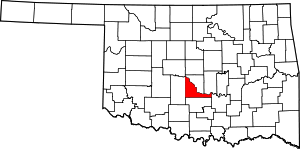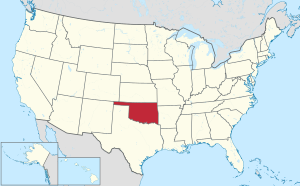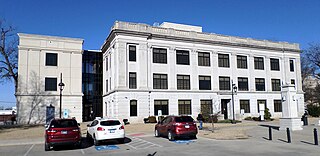
Pontotoc County is in the south central part of Oklahoma. As of the 2020 census, the population was 38,065. Its county seat is Ada. The county was created at statehood from part of the Chickasaw Nation in Indian Territory. It was named for a historic Chickasaw tribal area in Mississippi. According to the Encyclopedia of Oklahoma History and Culture, Pontotoc is usually translated "cattail prairie" or "land of hanging grapes."

Murray County is a county located in the southern part of the U.S. state of Oklahoma. As of the 2020 census, the population was 13,904. The county seat is Sulphur. The county was named for William H. Murray, a member and president of the Oklahoma Constitutional Convention and later a Governor of Oklahoma.

Grady County is a county located in the U.S. state of Oklahoma. As of the 2020 census, the population was 54,795. Its county seat is Chickasha. It was named for Henry W. Grady, an editor of the Atlanta Constitution and southern orator.

Garvin County is a county in south-central Oklahoma, United States. As of the 2020 census, the population was 25,656. Its county seat is Pauls Valley. In 1906, delegates to Constitution Convention formed Garvin County from part of the Chickasaw Nation, Indian Territory. The county was named for Samuel J. Garvin, a local Chickasaw rancher, merchant and banker. Its economy is largely based on farming, ranching and oil production.

Cleveland County is a county in the central part of the U.S. state of Oklahoma. The population was 295,528 at the 2020 United States census, making it the third-most populous county in Oklahoma. Its county seat is Norman. The county was named for U.S. President Grover Cleveland.
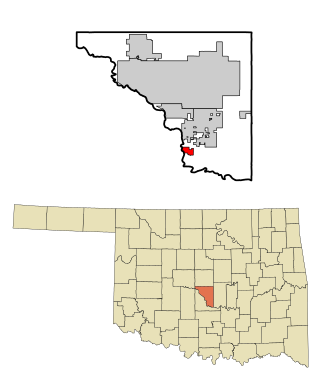
Lexington is a city in Cleveland County, Oklahoma, United States. The city population was 2,010 at the 2020 census, a 6.6% decrease from 2010.

Lindsay is a city in Garvin County, Oklahoma, United States. The population was 2,840 at the 2010 census. It once promoted itself as "The Broomcorn Capital of the World" but no longer uses that slogan, as broomcorn is no longer raised in the area.

Maysville is a town in Garvin and McClain counties, Oklahoma, United States. The population was 1,232 at the 2010 census, down from 1,313 in 2000.
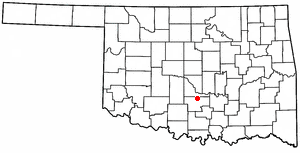
Paoli is a town in Garvin County, Oklahoma, United States. The population was 610 at the 2010 census. It was named after Paoli, Pennsylvania, an unincorporated community near Philadelphia from which many of the railroad workers who built the town came.

Wynnewood is a city in Garvin County, Oklahoma, United States. It is 67 miles (108 km) south of Oklahoma City. The population was 1,927 at the time of the 2020 census. Located in what was then the Chickasaw Nation of Indian Territory, it began as a village called "Walner" in 1886, on the proposed route of the Gulf, Colorado and Santa Fe Railway. Railroad workers from Pennsylvania named the community for Wynnewood, a community outside of Philadelphia. The name became official on April 6, 1887.

Dibble is a town in McClain County, Oklahoma, United States. The population within city limits was 867 at the 2020 census, down from 878 at the 2010 census. The community has 8,868 residents in its 73031 zipcode, according to Sperling's Best Places. Dibble is in the outer suburban area west of Purcell and southwest of Norman, in the Oklahoma City Metropolitan Area, according to the U.S. Census.

Newcastle is a city in McClain County, Oklahoma, United States, and part of the Oklahoma City Metropolitan Area. The population was 10,984 at the 2020 census.

Purcell is a city in and the county seat of McClain County, Oklahoma, United States. As of the 2020 census, the city population was 6,651, a 13% increase from 2010.

Blanchard is a city in McClain and Grady counties in the U.S. state of Oklahoma. The population was 8,879 at the 2020 census, up from 7,670 at the 2010 census. Blanchard is part of a rapidly growing area of northern McClain and Grady counties known as the "Tri-City Area" with Newcastle and Tuttle.
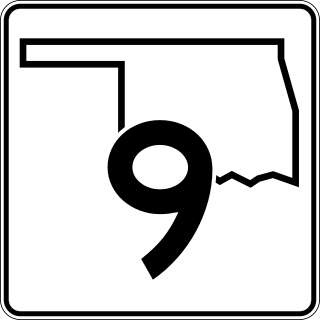
State Highway 9, abbreviated as SH-9, OK-9, or simply Highway 9, is a major east–west highway in the U.S. state of Oklahoma. Spanning across the central part of the state, SH-9 begins at the Texas state line west of Vinson, Oklahoma, and ends at the Arkansas state line near Fort Smith, Arkansas. State Highway 9 is a major highway around the Norman area. At 348.1 miles (560.2 km), SH-9 is Oklahoma's second-longest state highway.

State Highway 24 (SH-24) is a highway maintained by the U.S. state of Oklahoma. It runs for 21.1 miles (34.0 km) through central Oklahoma, almost entirely within McClain County. It is signed north–south and has no lettered spur routes.
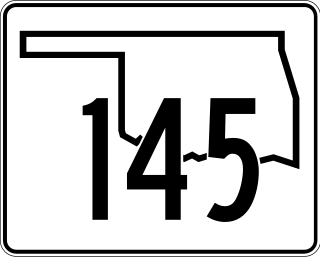
State Highway 145, abbreviated as SH-145 or OK-145, is a short, 2.88 miles (4.63 km) highway in Garvin County, Oklahoma. It connects Interstate 35 at its west end to US-77 in Paoli at its east end. It does not have any spur routes.
Bridge Creek is a town in Grady County, Oklahoma, United States. As of the 2020 census, the town population was 336, a 0% change from 2010.
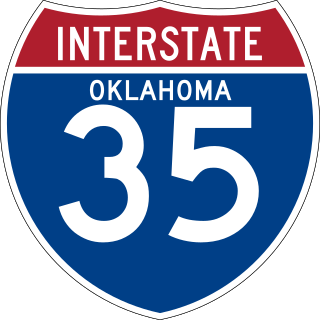
Interstate 35 (I-35), in the US State of Oklahoma, runs from the Red River at the Texas border to the Kansas state line near Braman for a length of 236 miles (380 km). I-35 has one auxiliary route in the state, I-235, in the inner city of Oklahoma City. A second auxiliary route, I-335, is planned as the designation for the Kickapoo Turnpike, although it will not meet I-35 until the southern extension of the turnpike to a junction with I-35 in Purcell is built. Excluding the Panhandle, I-35 forms the informal bisector for central Oklahoma, and along with US 81/US 283 in western Oklahoma and US 69/US 75 in the eastern portion, it provides one of the main north-south corridors through the state.

James Clark "Jim" Nance was a leader for 40 years in the Oklahoma Legislature in the U.S. state of Oklahoma and was community newspaper chain publisher 66 years. Nance served as Speaker of the Oklahoma House of Representatives and President pro tempore of the Oklahoma Senate. During his legislative career, Nance wrote the "Honest Mistake" law which became a model for other states. Nance then became a key sponsor and Legislative Chairman of the U.S. Uniform Law Commission (ULC), sponsored by the National Conference of Commissioners on Uniform State Laws, a non-partisan advisory panel which drafted uniform acts and uniform state commerce laws. Nance became known as a legislative expert in a 40-year legislative career as one of two Oklahomans to hold the top posts in both chambers of the Oklahoma Legislature. The state's largest newspaper, The Daily Oklahoman wrote he was the "longest serving Oklahoma Legislator" and "A Legislator's Legislator." Nance, a Democrat, is the only Oklahoma House Speaker elected through a bipartisan coalition of Democrats and Republicans. Fiercely independent, Nance considered public policy work to be a service and did not ever accept a salary or pension for any of his 40 years in the legislature and 24 years on the Uniform Law Commission. Nance refused to work as a lobbyist, although he had many offers after leaving office.

